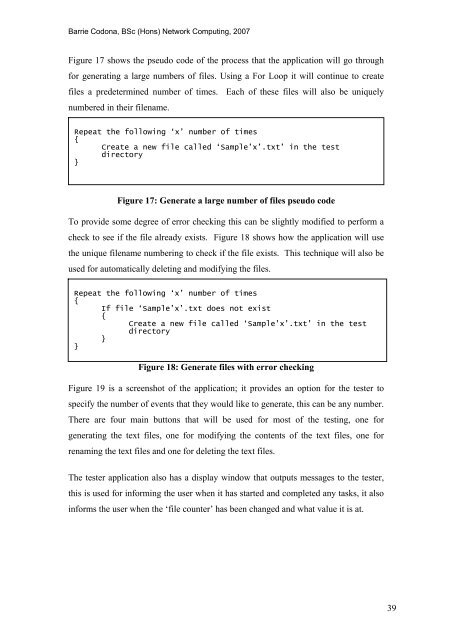Analysis and Evaluation of the Windows Event Log - Bill Buchanan
Analysis and Evaluation of the Windows Event Log - Bill Buchanan
Analysis and Evaluation of the Windows Event Log - Bill Buchanan
You also want an ePaper? Increase the reach of your titles
YUMPU automatically turns print PDFs into web optimized ePapers that Google loves.
Barrie Codona, BSc (Hons) Network Computing, 2007<br />
Figure 17 shows <strong>the</strong> pseudo code <strong>of</strong> <strong>the</strong> process that <strong>the</strong> application will go through<br />
for generating a large numbers <strong>of</strong> files. Using a For Loop it will continue to create<br />
files a predetermined number <strong>of</strong> times. Each <strong>of</strong> <strong>the</strong>se files will also be uniquely<br />
numbered in <strong>the</strong>ir filename.<br />
Repeat <strong>the</strong> following ‘x’ number <strong>of</strong> times<br />
{<br />
Create a new file called ‘Sample’x’.txt’ in <strong>the</strong> test<br />
directory<br />
}<br />
Figure 17: Generate a large number <strong>of</strong> files pseudo code<br />
To provide some degree <strong>of</strong> error checking this can be slightly modified to perform a<br />
check to see if <strong>the</strong> file already exists. Figure 18 shows how <strong>the</strong> application will use<br />
<strong>the</strong> unique filename numbering to check if <strong>the</strong> file exists. This technique will also be<br />
used for automatically deleting <strong>and</strong> modifying <strong>the</strong> files.<br />
Repeat <strong>the</strong> following ‘x’ number <strong>of</strong> times<br />
{<br />
If file ‘Sample’x’.txt does not exist<br />
{<br />
Create a new file called ‘Sample’x’.txt’ in <strong>the</strong> test<br />
directory<br />
}<br />
}<br />
Figure 18: Generate files with error checking<br />
Figure 19 is a screenshot <strong>of</strong> <strong>the</strong> application; it provides an option for <strong>the</strong> tester to<br />
specify <strong>the</strong> number <strong>of</strong> events that <strong>the</strong>y would like to generate, this can be any number.<br />
There are four main buttons that will be used for most <strong>of</strong> <strong>the</strong> testing, one for<br />
generating <strong>the</strong> text files, one for modifying <strong>the</strong> contents <strong>of</strong> <strong>the</strong> text files, one for<br />
renaming <strong>the</strong> text files <strong>and</strong> one for deleting <strong>the</strong> text files.<br />
The tester application also has a display window that outputs messages to <strong>the</strong> tester,<br />
this is used for informing <strong>the</strong> user when it has started <strong>and</strong> completed any tasks, it also<br />
informs <strong>the</strong> user when <strong>the</strong> ‘file counter’ has been changed <strong>and</strong> what value it is at.<br />
39










![Unit 5. Switches and VLANs [PDF]](https://img.yumpu.com/34422504/1/184x260/unit-5-switches-and-vlans-pdf.jpg?quality=85)





